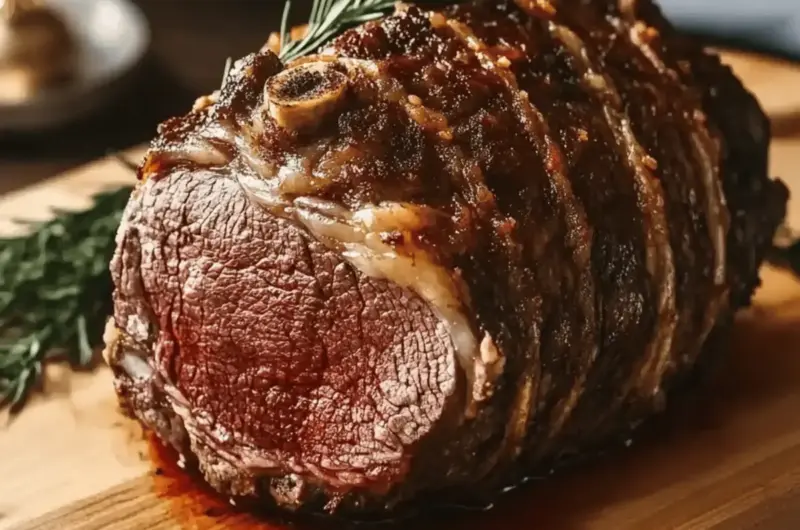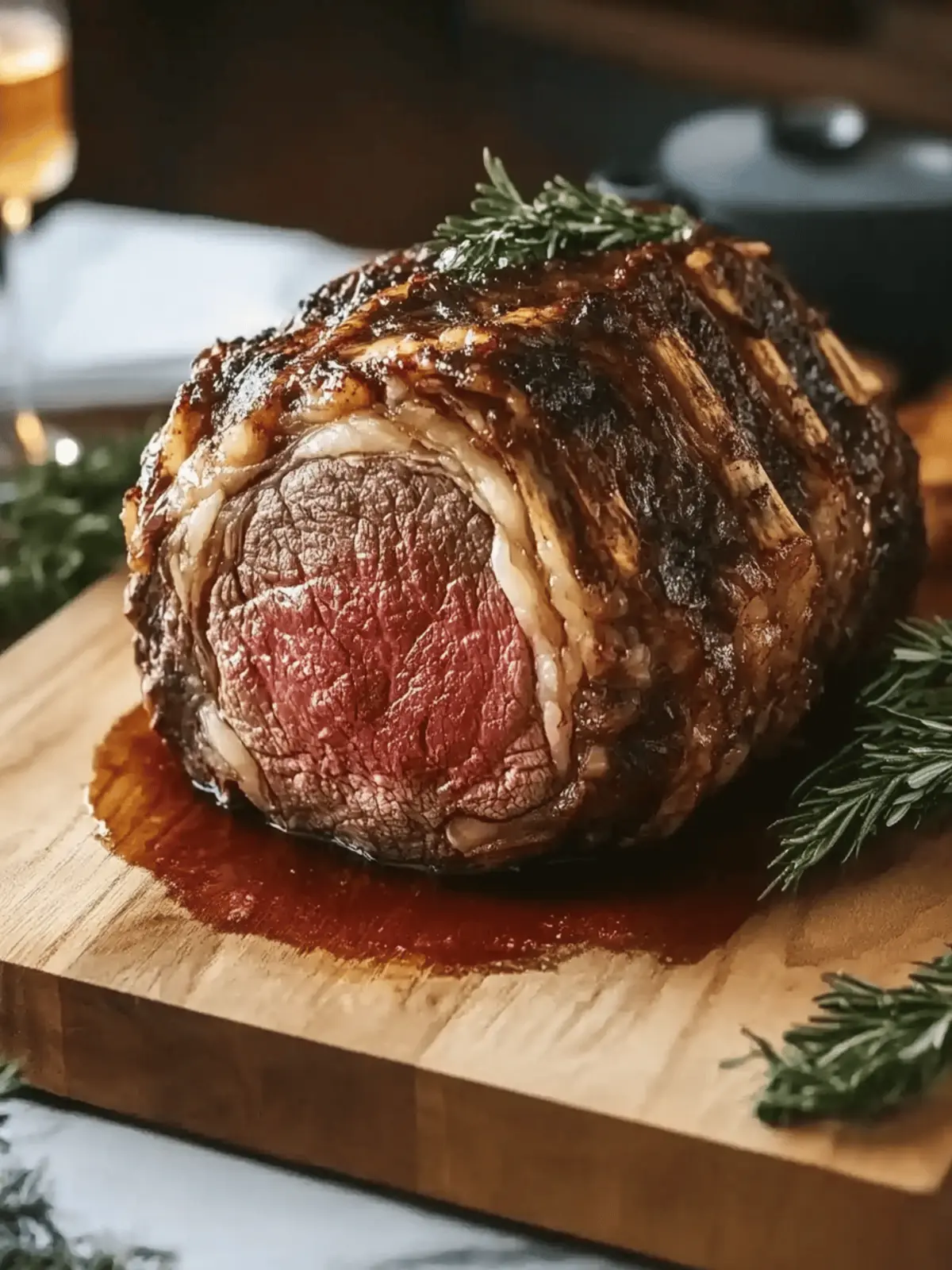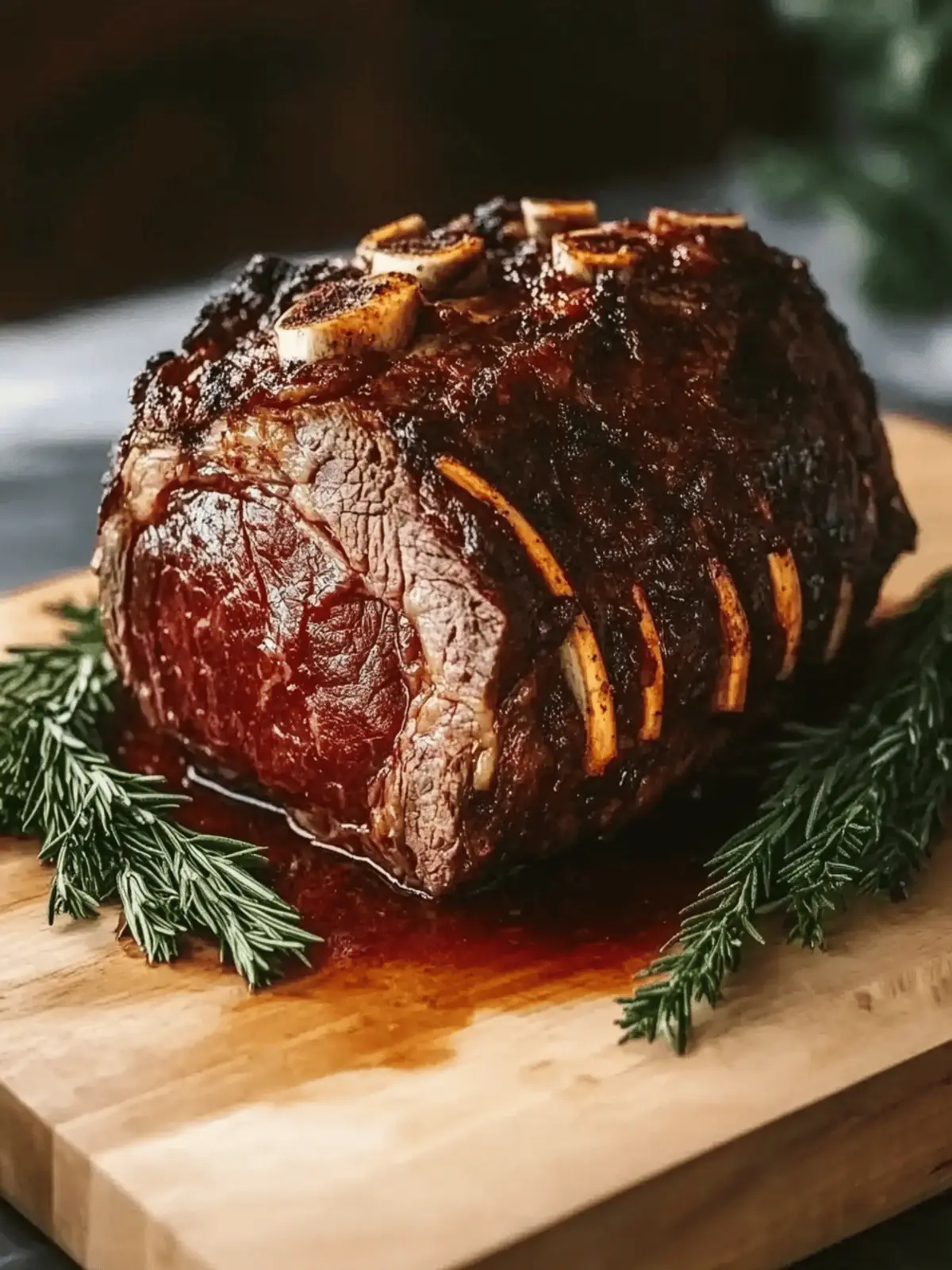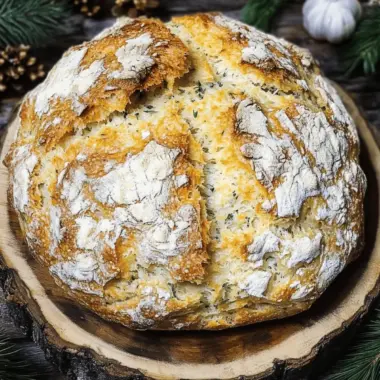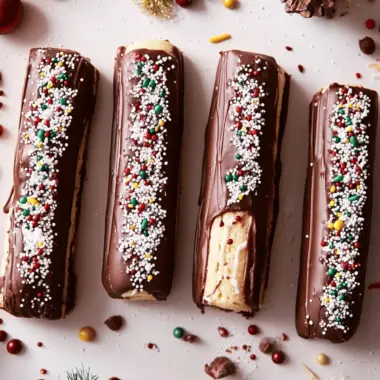When the holiday season rolls around, nothing quite compares to the warmth and joy of a festive table, especially when it features a Classic Christmas Prime Rib. The enticing aroma of garlic and herbs wafting through the house creates an atmosphere of celebration and togetherness, instantly elevating any gathering.
I remember one Christmas dinner when a beautifully roasted prime rib stole the show, leaving my guests eagerly anticipating every bite. With its rich flavor and tender pink center, this dish transforms even the simplest of holiday feasts into a luxurious dining experience.
What sets this recipe apart is its effortless approach; even if you’re new to cooking, you can achieve that restaurant-quality roast with my straightforward steps. Allow me to guide you through creating this sumptuous centerpiece that will not only impress your family and friends but also leave lasting memories of laughter and great food. Get ready to embrace the holiday spirit—let’s dive into my Classic Christmas Prime Rib recipe!
Why is Classic Christmas Prime Rib a Must-Try?
Indulgent Flavor: This prime rib boasts a rich, savory profile that transforms holiday gatherings into unforgettable feasts.
Effortless Cooking: Designed with simplicity in mind, it’s perfect for all skill levels—no culinary expertise needed!
Crowd-Pleasing Centerpiece: It’s the ideal dish to wow guests and create lasting memories around your festive table.
Aromatic Bliss: The fragrant blend of garlic and herbs fills your home, setting the perfect festive mood.
Versatile Pairing: Enjoy it alongside traditional sides like mashed potatoes or roasted Brussels sprouts for a complete holiday meal.
This iconic roast is not just a meal; it’s a celebratory experience!
Classic Christmas Prime Rib Ingredients
For the Prime Rib
- Prime Rib Roast – Choose a “Prime” or “Choice” grade for the best flavor and tenderness.
- Kosher Salt (30g) – Ideal for a dry brining process that enhances flavor when seasoned 24 hours in advance.
- Olive Oil (3 tbsp) – Used for browning the bones, it adds richness to the flavorful au jus.
For the Au Jus
- Meaty Bones (3 lbs – oxtails/neck bones) – These form the base of a richly flavored au jus.
- Garlic (5 cloves) – Essential for imparting aromatic flavor to the sauce.
- Carrots (2 large) – Sweetness from carrots adds depth and body to the au jus.
- Celery (3 ribs) – Contributes a subtle flavor complexity to balance the richness.
- Onion (1 large) – A foundational aromatic to deepen the overall flavor profile.
- Tomato Paste (1 tbsp) – Boosts color and adds richness to the au jus.
- Dry Red Wine (1/2 cup) – An excellent deglazing agent that enhances the complexity of flavors.
- Low-Sodium Beef Stock (6 cups) – Provides moisture and depth as the base for the au jus.
- Thyme Sprigs (2) – Herbal notes enrich the au jus with fragrant flavors.
- Bay Leaf (1) – Adds savory undertones for a perfectly balanced sauce.
For the Horseradish Sauce
- Sour Cream (1 cup) – Creates a creamy base that balances the sharpness of horseradish.
- Prepared Horseradish (5 tbsp) – This is the star ingredient that brings the necessary heat.
- Dijon Mustard (1 tbsp) – Introduces depth and a slight tang to the sauce.
- Worcestershire Sauce (2 tsp) – A touch of this sauce deepens the flavor profile.
- Mayonnaise (2 tbsp) – Adds creaminess to blend all the flavors beautifully.
Gather these ingredients and prepare to create a Classic Christmas Prime Rib that will wow your guests and elevate your holiday celebrations!
How to Make Classic Christmas Prime Rib
-
Prepare the Roast: Season your prime rib generously with kosher salt 24 hours before cooking. This dry brining process enhances the meat’s rich flavor and tenderness—your friends and family will be impressed!
-
Bring to Room Temperature: On the day of cooking, allow the roast to sit out for 5-6 hours until it reaches room temperature. This step promotes even cooking, ensuring a perfectly tender outcome.
-
Preheat the Oven: Preheat your oven to 250°F (120°C). A low and slow roast allows the flavors to develop richly and keeps the meat wonderfully succulent, so resist the urge to crank up the heat!
-
Prepare Au Jus:
- Brown the Bones: In a pot, heat olive oil over medium heat and brown the meaty bones for 10-12 minutes. This process adds depth to your au jus.
- Sauté Aromatics: Add garlic, carrots, celery, onion, and tomato paste; sauté for 10 minutes until softened and fragrant.
- Deglaze: Pour in the dry red wine, scraping the bottom of the pot to incorporate the flavorful bits. Then, add the beef stock and herbs, bringing it to a gentle simmer while the prime rib roasts.
-
Roast the Meat: Insert a meat thermometer into the thickest part of the prime rib. Cook until the internal temperature hits 115°F for rare or 120°F for medium-rare, which usually takes about 3 hours. Keep your eye on that thermometer for perfect results!
-
Rest the Roast: Once cooked, carefully remove the roast from the oven and tent it with foil. Let it rest for 20-30 minutes. This essential step allows the juices to redistribute, resulting in a moist, flavorful roast.
-
Finish with Broiling: For a beautiful crust, broil the roast for 1-2 minutes on each side. Keep an eye on it, as it can brown quickly!
-
Prepare Horseradish Sauce: In a bowl, mix sour cream, prepared horseradish, Dijon mustard, Worcestershire sauce, and mayonnaise until smooth. This tangy sauce will perfectly complement your rich prime rib.
-
Slice and Serve: Slice the roast and serve with the homemade au jus and horseradish sauce. This presentation is sure to leave your guests in awe!
Optional: Garnish with fresh thyme sprigs for a lovely touch.
Exact quantities are listed in the recipe card below.
Make Ahead Options
These Classic Christmas Prime Rib preparations are just the ticket for busy holiday cooks! You can season the prime rib with kosher salt up to 24 hours in advance, enhancing its flavor through dry brining. Additionally, to streamline your cooking process, prepare the au jus and horseradish sauce the day before; refrigerate them and bring them to room temperature before serving. The finished prime rib can be refrigerated for up to 3 days; simply reheat gently in the oven, ensuring it doesn’t dry out. With these make-ahead steps, you’ll save time on the big day while still serving a mouthwatering centerpiece that’s just as delicious as freshly cooked!
Expert Tips for Classic Christmas Prime Rib
- Room Temperature Check: Always allow your roast to come to room temperature before cooking. This ensures even cooking and prevents a cold center in your Classic Christmas Prime Rib.
- Thermometer Precision: Investing in a reliable meat thermometer is essential. This avoids overcooking, helping you achieve that perfect medium-rare without guesswork.
- Resting Period: Don’t skip the resting step! Tent your roast with foil for 20-30 minutes to let the juices redistribute, keeping your meat moist and flavorful.
- Low and Slow: Keep your oven at the recommended 250°F (120°C) for slow-roasting. Cranking the heat can lead to tough meat and uneven cooking.
- Broiling Tip: Broil for only 1-2 minutes per side to get that crust you crave without burning. Keep a close watch—things can get toasty quickly!
What to Serve with Classic Christmas Prime Rib?
The festive table deserves delightful companions to complement your succulent roast and create a feast of flavors.
-
Creamy Mashed Potatoes: Their buttery richness pairs perfectly with the savory elements of the prime rib, soaking up every delicious drop of au jus.
-
Roasted Brussels Sprouts: The caramelized edges of Brussels sprouts add a crispy bite and earthy flavor, balancing the lushness of the prime rib.
-
Yorkshire Pudding: This traditional side soaks up the juices beautifully, providing a light, airy texture that contrasts the richness of the meat.
-
Garlic Green Beans: Tender green beans tossed in garlic and olive oil offer freshness that brightens the plate, making every bite a harmonious blend.
-
Rich Gravy: Pouring homemade gravy over the roast enhances each slice, marrying the flavors with an extra layer of savory goodness.
-
Herb-Infused Rice Pilaf: The fragrant herbs and tender grains add an aromatic touch, serving as a wonderful base for the robust flavors of the prime rib.
-
Red Wine: Pair your meal with a glass of bold red wine to uplift the dining experience, highlighting the complex flavors of the roast.
-
Dark Chocolate Tart: For dessert, this rich tart adds a touch of indulgence and rounds off the meal with a luxurious finish—because no holiday feast is complete without something sweet!
Classic Christmas Prime Rib Variations
Feel free to mix things up and personalize your festive feast with these exciting twists!
-
Different Cuts: Swap out prime rib for ribeye or sirloin for unique flavor profiles and textures. Each cut brings its own story to the table.
-
Herb Infusion: Experiment by adding rosemary or oregano along with thyme for a fragrant twist. These herbs elevate the classic savory notes, making your dish truly special.
-
Smoked Flavor: Try a smoked version! Slow-cook the prime rib on a smoker for 4-6 hours to achieve a deep, smoky richness that your guests will rave about.
-
Spice It Up: Add crushed red pepper flakes to the horseradish sauce for a zesty kick. The heat complements the creaminess beautifully, igniting the taste buds with every bite.
-
Veggie Rich Au Jus: Toss in mushrooms or bell peppers with the au jus for an added layer of flavor. A touch of earthiness balances perfectly with the beef’s richness.
-
Wine Variety: Substitute the dry red wine with a fortified wine like port for a sweeter, deeper flavor profile in your au jus. This nuanced shift can make all the difference.
-
Glaze Finish: Brush a maple or brown sugar glaze on the prime rib in the last 30 minutes of roasting for an unexpected sweetness. The contrast between sweet and savory is divine!
-
Dairy-Free Horseradish Sauce: Replace sour cream with a cashew cream or coconut yogurt for a dairy-free version that still packs a punch. Everyone can enjoy the richness without any restrictions!
How to Store and Freeze Classic Christmas Prime Rib
Fridge: Keep leftovers tightly wrapped in foil or an airtight container for up to 3 days. This keeps your prime rib moist while preserving its rich flavors.
Freezer: For longer storage, wrap slices in plastic wrap followed by foil, or use a vacuum sealer. Classic Christmas Prime Rib can be frozen for up to 3 months without compromising taste.
Reheating: To reheat, thaw overnight in the fridge, then warm in a 250°F (120°C) oven until heated through, about 20-30 minutes. This method helps retain moisture and tenderness.
Avoid Room Temperature: Do not leave cooked prime rib at room temperature for more than 2 hours to ensure its flavor and safety.
Classic Christmas Prime Rib Recipe FAQs
What is the best way to select a prime rib roast?
Absolutely! When choosing a prime rib roast, look for “Prime” or “Choice” grade cuts, as these offer the best flavor and tenderness. Specifically, opt for a cut from the smaller end near the loin, which tends to be more tender and juicy.
How should I store leftover prime rib?
To store leftover Classic Christmas Prime Rib, wrap it tightly in foil or place it in an airtight container. It can be kept in the refrigerator for up to 3 days. Make sure it’s in a temperature-controlled area, ideally below 40°F (4°C), to maintain its freshness.
Can I freeze prime rib, and if so, how?
Definitely! To freeze your Classic Christmas Prime Rib, first wrap slices in plastic wrap to prevent freezer burn. Then, wrap the package in aluminum foil or use a vacuum sealer for best results. Properly wrapped, it can be frozen for up to 3 months. When you’re ready to enjoy it again, thaw it overnight in the refrigerator for safe and gradual defrosting.
What should I do if my prime rib is overcooked?
Don’t worry—there’s always a silver lining! If your Classic Christmas Prime Rib is overcooked, you can try a couple of tricks. Thinly slice the roast against the grain and serve it with a generous amount of au jus or a rich gravy to help retain moisture. If it’s particularly dry, consider adding a creamy horseradish sauce or serve it in a sandwich with a bit of broth to enhance flavor and juiciness.
Is prime rib safe for pets?
While a small piece of cooked prime rib may not harm your pets, it’s best to avoid giving them seasoned or sauced meat, as many ingredients in preparation can be harmful to animals. Stick to plain, unseasoned roast beef in moderation if you’d like to share a treat with your furry friend. Always consult your vet for guidance on your pet’s diet.
Can I modify the horseradish sauce for personal preferences?
Very! You can absolutely adjust the flavor of the horseradish sauce to your taste. If you prefer a spicier kick, add more prepared horseradish. For a milder flavor, simply reduce the amount or mix in some additional sour cream to balance out the heat. Play around with the ingredients until it’s just right for your palate!

Classic Christmas Prime Rib That Will Wow Your Guests
Ingredients
Equipment
Method
- Prepare the Roast: Season your prime rib generously with kosher salt 24 hours before cooking.
- Bring to Room Temperature: Allow the roast to sit out for 5-6 hours until it reaches room temperature.
- Preheat the Oven: Preheat your oven to 250°F (120°C).
- Prepare Au Jus: Brown the bones in olive oil for 10-12 minutes, then sauté garlic, carrots, celery, onion, and tomato paste for 10 minutes. Deglaze with dry red wine, then add beef stock and herbs.
- Roast the Meat: Cook until the internal temperature hits 115°F for rare or 120°F for medium-rare, about 3 hours.
- Rest the Roast: Tent with foil and let it rest for 20-30 minutes.
- Finish with Broiling: Broil for 1-2 minutes on each side for a crust.
- Prepare Horseradish Sauce: Mix sour cream, horseradish, Dijon mustard, Worcestershire sauce, and mayonnaise until smooth.
- Slice and Serve: Slice the roast and serve with au jus and horseradish sauce.

